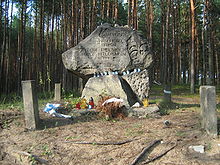Reserve Police Battalion 101
RPB 101 guarded Polish prisoners of war and carried out expulsion of Poles, called "resettlement actions", in the new Warthegau territory around Poznań and Łódź.
[1] After a few months of active duty the battalion was transported from Kielce, Poland, back to Germany on 17 December 1939 to undergo a major expansion after Christmas.
— Bruno Probst[18]For the next half-year, beginning 28 November 1940, Police Battalion 101 guarded the new ghetto in Łódź, eventually crammed with 160,000 Jews.
[25] Battalion 101, commanded by career policeman Major Wilhelm Trapp,[26] returned to Hamburg in May 1941 and again the more experienced servicemen were dispatched to organize more units.
[30] By that time, the first two extermination camps of Operation Reinhard in General Government – Bełżec and Sobibor – were already gassing trainloads of Jews from all over Europe.
Between mid-March and mid-April 1942, about 90% of the 40,000 prisoners of the Lublin Ghetto were loaded by Order Police and Schupo onto trains destined for Bełżec extermination camp.
[32] The first mass murder known to have been committed entirely by Reserve Police Battalion 101 was the most "messy" for lack of training; uniforms dripping wet with brain matter and blood.
[33] The murder of 1,500 Jews from Józefów ghetto, approximately 100 km (62 mi) south of Lublin in south-eastern Poland, on 13 July 1942 was performed mostly by the three platoons of the Second Company.
[34] Those of them who felt unable to continue shooting at point-blank range of prisoners begging for mercy, were asked to wait at the marketplace where the trucks were loaded.
The bodies of their victims carpeting the forest floor at the Winiarczykowa Góra hill (about 2 km (1.2 mi) from the village, pictured) were left unburied.
Later that day, the Hiwi shooters arrived at the main square, and some 1,700 ghetto prisoners were marched on foot to the Hały forest outside the town, where the stronger Jewish men prepared a trench with entrance on one side.
The Ukrainian Trawnikis got so drunk that the policemen from the first, second and third platoons (Lieutenant Hartwig Gnade) had to continue shooting by themselves in half a metre of groundwater and blood.
From Radzyń 6,000 prisoners, then from Łuków (7,000), Końskowola (2,000 coupled with the massacre at the hospital), Komarówka, Tomaszów; all those unable to move or attempting to flee were shot on the spot.
[44][clarification needed] In Izbica, the makeshift ghetto reached a breaking point packed by Gnade with Jewish inhabitants of Biała Podlaska, Komarówka, Wohyń, and Czemierniki.
After questioning by the Polish Military Mission for the Investigations of War Crimes in October 1946, he was extradited to Poland along with Drewes, Bumann and Kadler.
[52] Trapp was charged with war crimes by the Siedlce District Court, sentenced to death on 6 July 1948 and executed by hanging on 18 December 1948 along with Gustav Drewes.
[55] For the most part, the following table is based on the 1968 verdict of the Hamburg District Court and compared with data from the Museum of the History of the Polish Jews and other searchable databases.


